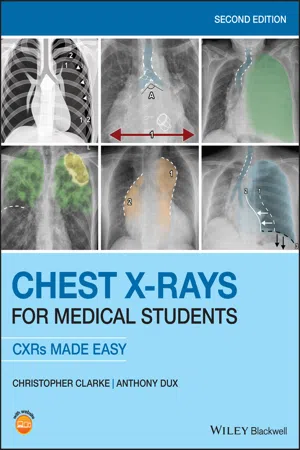
- English
- ePUB (mobile friendly)
- Available on iOS & Android
About this book
Chest X-rays for Medical Students offers a fresh analytical approach to identifying chest abnormalities, helping medical students, junior doctors, and nurses understand the underlying physics and basic anatomical and pathological details of X-ray images of the chest. The authors provide a memorable framework for analysing and presenting chest radiographs, with each radiograph appearing twice in a side-by-side comparison, one as seen in a clinical setting and the second highlighting the pathology.
This new second edition includes significant revisions, improved annotations of X-rays, expanded pathologies, and numerous additional high-quality images. A comprehensive one-stop guide to learning chest radiograph interpretation, this book:
- Aligns with the latest Royal College of Radiologists' Undergraduate Radiology Curriculum
- Offers guidance on how to formulate normal findings
- Features self-assessment tests, presentation exercises, and varied examples
- Includes sections on radiograph quality X-ray hazards and precautions
Chest X-rays for Medical Students is an ideal study guide and clinical reference for any medical student, junior doctor, nurse or radiographer.
Frequently asked questions
- Essential is ideal for learners and professionals who enjoy exploring a wide range of subjects. Access the Essential Library with 800,000+ trusted titles and best-sellers across business, personal growth, and the humanities. Includes unlimited reading time and Standard Read Aloud voice.
- Complete: Perfect for advanced learners and researchers needing full, unrestricted access. Unlock 1.4M+ books across hundreds of subjects, including academic and specialized titles. The Complete Plan also includes advanced features like Premium Read Aloud and Research Assistant.
Please note we cannot support devices running on iOS 13 and Android 7 or earlier. Learn more about using the app.
Information
II
The ABCDE of chest X‐rays
- Look at the trachea and right and left main bronchi.
- Look to see if the lungs are uniformly expanded and compare the lung fields.
- Look around the edges of each lung.
- Look at the costophrenic angles and the four silhouettes.
- Look at the cardiac size.
- Look at the great vessels (pulmonary vessels and aorta).
- Look at the mediastinum and hila.
- Look for a fracture, especially of the ribs or shoulder girdle.
- Look for gas under the diaphragm.
- Look for surgical emphysema.
- Look for both breast shadows.
- Look for foreign bodies and medical interventions.
6
A – Airway
How to review the airway

What to look for
| p. 24 |
| p. 25 |
Tracheal deviation
- Deviated towards diseased side (conditions that pull the trachea):
- lung collapse;
- pneumonectomy (removal of a lung) or lobectomy (removal of just one lobe);
- unilateral fibrosis;
- agenesis of lung (also called lung aplasia – complete absence of a whole lung and its bronchus).
- Deviated away from diseased side (conditions that push the trachea):
- tension pneumothorax;
- massive pleural effusion;
- mediastinal masses;
- para‐tracheal masses.
Table of contents
- Cover
- Table of Contents
- Preface to the 2nd Edition
- Acknowledgements
- Learning objectives checklist
- About the companion website
- I: Introduction to X‐rays
- II: The ABCDE of chest X‐rays
- III: Common conditions and their radiological signs
- Glossary
- Index
- End User License Agreement